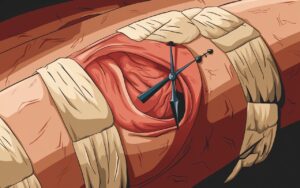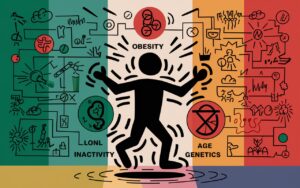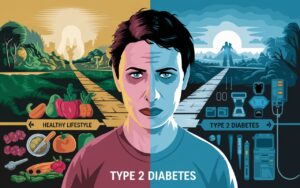Last Updated on September 5, 2024 by Alexander Sennuga
Spotting the signs of prediabetes can feel overwhelming, but recognizing them early is your ticket to staying healthy.
Have you noticed feeling unusually tired or experiencing unexplained weight changes? These might be more than just life wearing you down—they could be crucial signals from your body.
Prediabetes is a wake-up call, not a life sentence, and understanding these signs empowers you to take proactive steps.
Imagine knowing how to prevent diabetes with just a few lifestyle tweaks. It’s about making small, meaningful changes that can alter the course of your health.
Curious to learn more?
Let’s dive in and explore how you can recognize these signs, and take charge of your well-being starting today.
Understanding Prediabetes
Prediabetes is a health condition where blood sugar levels are higher than normal but not high enough to be classified as type 2 diabetes.
Recognizing the signs of prediabetes is crucial because it often serves as a warning sign that you’re at risk of developing diabetes and other related health issues.
Early detection can lead to proactive measures, such as lifestyle changes, that can prevent or delay the onset of type 2 diabetes.
The signs of prediabetes can be subtle and often go unnoticed, which is why regular screenings are important, especially if you have risk factors like obesity, a sedentary lifestyle, or a family history of diabetes.
Common indicators include fatigue, unexplained weight fluctuations, and increased thirst. Frequent urination and blurry vision may also be warning signs of prediabetes. Moreover, high blood pressure and abnormal cholesterol levels can accompany prediabetes, further highlighting the importance of comprehensive health assessments.
Understanding these signs is the first step towards managing your health. By recognizing and addressing prediabetes early, you can significantly reduce the risk of developing more severe health conditions.
Incorporating healthier eating habits, increasing physical activity, and maintaining a healthy weight are effective strategies to control blood sugar levels and improve overall well-being.
Sign 1: Increased Thirst and Frequent Urination

Increased thirst and frequent urination are two early signs of prediabetes that warrant attention. These symptoms occur as your body struggles to regulate blood sugar levels, leading to excessive glucose in the bloodstream.
As the kidneys work overtime to filter and absorb this excess sugar, you may experience heightened thirst and the need to urinate more often.
Recognizing these signs of prediabetes is crucial for early intervention, allowing you to take proactive steps toward managing your health. By addressing these symptoms early, you can adopt lifestyle changes that help prevent the progression of type 2 diabetes, ensuring better long-term health outcomes.
One of the earliest signs of prediabetes is an increase in thirst and the need to urinate more frequently. When blood sugar levels rise, the body tries to flush out excess glucose through urine. This leads to increased urination, which in turn causes dehydration and triggers thirst.
What to look out for:
- Feeling thirsty more often than usual
- Waking up at night to use the bathroom
- Needing to drink water immediately after urinating
If you notice these changes, it’s important to monitor your fluid intake and consult with a healthcare provider about getting your blood sugar levels checked.
Sign 2: Unexplained Weight Loss

Unexplained weight loss can be an alarming yet often overlooked sign of prediabetes. While many people regard weight loss as a positive change, losing weight without making lifestyle adjustments could indicate underlying health issues.
In the context of blood sugar imbalances, your body may not use glucose efficiently for energy, leading it to break down muscle and fat for fuel instead.
This process results in unintended weight loss, which serves as a warning sign of prediabetes.
Identifying these signs of prediabetes is essential for early intervention and prevention of further health complications. If you notice unexpected weight loss, combined with other symptoms like increased thirst or frequent urination, it’s important to consult a healthcare professional for proper evaluation.
Taking action can prevent the progression of type 2 diabetes. Being aware of these signs empowers you to make informed decisions about your health, paving the way for effective management and prevention strategies.
While obesity is a risk factor for prediabetes, unexplained weight loss can also be a sign of the condition. When the body can’t effectively use glucose for energy due to insulin resistance, it starts breaking down fat and muscle for fuel.
This can result in unintended weight loss.
Key points:
- Weight loss of 5-10 pounds without changes in diet or exercise
- Loss of muscle mass
- Feeling hungry despite eating regular meals
It’s crucial to note that not everyone with prediabetes experiences weight loss. Some may maintain their weight or even gain weight. If you notice unexplained weight changes, consult your doctor.
Sign 3: Fatigue and Weakness

Fatigue and weakness are common yet often overlooked signs of prediabetes. These symptoms emerge as the body’s response to imbalances in blood glucose levels.
In prediabetes, the body either doesn’t produce enough insulin or doesn’t use it effectively, causing glucose to accumulate in the bloodstream rather than being converted into energy.
This inefficiency can lead to a persistent sense of tiredness and a lack of energy, even after resting.
For many, this fatigue can be profound, affecting daily activities and overall quality of life. Recognizing these signs of prediabetes is crucial as it enables early intervention.
Prompt actions, such as adjusting your diet, increasing physical activity, and consulting healthcare professionals, can significantly mitigate the risk of developing full-blown diabetes and restore vitality.
Awareness and proactive management of these symptoms can lead to better health outcomes and prevent more serious complications associated with diabetes.
Common experiences:
- Feeling exhausted despite getting enough sleep
- Difficulty concentrating or staying alert during the day
- Needing more caffeine than usual to stay awake
While fatigue can be caused by many factors, persistent tiredness combined with other signs of prediabetes warrants a visit to your healthcare provider.
Sign 4: Blurred Vision

Blurred vision is one of the subtle yet significant signs of prediabetes that individuals should not ignore. This symptom arises when fluctuating blood sugar levels lead to swelling in the eye’s lens, affecting the ability to focus and causing vision to become blurry.
For many, this change in eyesight can be sudden and unsettling, often leading to difficulties in daily activities like reading or driving. Recognizing blurred vision as a sign of prediabetes is vital for early detection and intervention.
Addressing this issue can help prevent further complications and deterioration of eye health. If you experience unexplained vision changes, it’s important to consult a healthcare professional to assess your blood sugar levels and overall health.
Taking timely corrective measures, such as lifestyle modifications and regular monitoring, can manage these signs of prediabetes effectively, reducing the risk of progression to type 2 diabetes and preserving long-term visual health.
What to watch for:
- Sudden changes in vision clarity
- Difficulty reading or seeing distant objects
- Frequent changes in eyeglass or contact lens prescriptions
If you experience persistent vision changes, seeing an eye doctor and checking your blood sugar levels is essential.
Sign 5: Slow-Healing Wounds

Slow-healing wounds are a noticeable but often underestimated indicator among the signs of prediabetes. When blood sugar levels are consistently elevated, they can impair the body’s natural healing processes.
High glucose levels can lead to poor circulation and affect the body’s ability to repair tissues, slowing down healing and making you more susceptible to infections.
If you observe that small cuts, bruises, or sores are taking longer than usual to heal, it’s essential to consider this as a potential warning sign of prediabetes.
This delayed healing can have significant implications, affecting your quality of life and increasing the risk of more serious complications if left unchecked.
Understanding this symptom enables early intervention, allowing you to take proactive steps toward better blood sugar management and healthcare.
Lifestyle changes, such as improved diet and exercise, can significantly enhance your body’s healing capacity and help prevent the progression of type 2 diabetes.
Signs to look out for:
- Wounds that remain open for weeks
- Frequent infections
- Slow recovery from minor injuries
If you notice a pattern of slow healing, especially in combination with other symptoms, consult your healthcare provider.
Sign 6: Darkened Skin Patches

Darkened skin patches, a condition known as acanthosis nigricans, can be a visible sign of prediabetes that should not be overlooked. This discoloration, often appearing on the neck, armpits, or groin, is caused by excess insulin in the body, a hallmark of prediabetes.
As insulin levels rise, the skin responds by thickening and darkening, creating these distinctive patches. Recognizing this sign of prediabetes is crucial, as it can serve as an early warning sign of potential health issues.
If you notice these changes in your skin, it’s important to consult a healthcare professional for proper evaluation and management.
Addressing the underlying prediabetes through lifestyle modifications, such as diet and exercise, can help reverse the skin discoloration and prevent the progression to type 2 diabetes.
By being aware of this visible symptom, you can take proactive steps to safeguard your overall health and well-being.
Common areas affected:
- Neck
- Armpits
- Groin
- Elbows
- Knees
While not everyone with prediabetes develops acanthosis nigricans, its presence, especially in combination with other risk factors, should prompt a discussion with your doctor.
Sign 7: Increased Hunger

Increased hunger is one of the early signs of prediabetes that many people might overlook. As your body struggles to use insulin effectively, blood sugar levels fluctuate, leaving your cells starved for energy.
This can trigger your brain to signal hunger more frequently, even after eating a meal. Recognizing this symptom as a potential sign of prediabetes is crucial for taking proactive steps toward better health.
The persistent feeling of hunger, coupled with inadequate satisfaction from typical meal portions, can lead to overeating and eventually weight gain, which further exacerbates the risk of developing type 2 diabetes.
Understanding increased hunger as one of the key signs of prediabetes empowers you to make informed changes in your diet and lifestyle, potentially reversing the progression.
If you notice a constant urge to eat despite consuming adequate meals, consider seeking medical advice to evaluate your risk of prediabetes and explore preventative measures.
What you might experience:
- Feeling hungry shortly after eating a meal
- Craving carbohydrates or sugary foods
- Eating more than usual without weight gain
Risk Factors for Prediabetes

Understanding the risk factors for prediabetes is essential in recognizing the early signs of prediabetes and taking preventative action. Prediabetes occurs when blood sugar levels are higher than normal but not yet high enough to be classified as diabetes.
Several risk factors increase the likelihood of developing prediabetes, putting individuals at risk of progressing to type 2 diabetes if left unmanaged. Common risk factors include being overweight, having a sedentary lifestyle, and having a family history of diabetes.
Additionally, age plays a role, with individuals over 45 being more susceptible. Certain ethnicities, such as African American, Hispanic, Native American, and Asian American, are at a higher risk.
Unhealthy dietary habits, high blood pressure, and abnormal cholesterol levels also contribute significantly.
By understanding these risk factors and identifying the signs of prediabetes, such as fatigue, increased thirst, and frequent urination, you can take proactive steps in consultation with healthcare professionals to mitigate the risk and lead a healthier life.
Some key risk factors include:
- Obesity: Excess body fat, especially around the waist, increases the risk of insulin resistance.
- Family history: Having a parent or sibling with type 2 diabetes raises your risk.
- Age: The risk increases as you get older, particularly after age 45.
- Sedentary lifestyle: Lack of regular physical activity contributes to insulin resistance.
- Unhealthy diet: Consuming a diet high in processed foods, sugars, and unhealthy fats can increase risk.
- Gestational diabetes: Women who had diabetes during pregnancy are at higher risk.
- Polycystic ovary syndrome (PCOS): This hormonal disorder is associated with insulin resistance.
- Certain medications: Some drugs, like corticosteroids, can increase blood sugar levels.
Diagnosing Prediabetes
Diagnosing prediabetes is a crucial step in managing and preventing the progression of type 2 diabetes.
Recognizing the early signs of prediabetes, such as increased thirst, frequent urination, and fatigue, can prompt individuals to seek medical evaluation. Early diagnosis is key because prediabetes often presents without obvious symptoms.
These tests measure average blood sugar levels and determine whether they fall in the prediabetic range. Understanding and identifying the signs of prediabetes through these diagnostic tests provide a valuable opportunity to make lifestyle changes that can prevent or delay the onset of type 2 diabetes.
By working closely with healthcare providers, individuals can create effective strategies that include healthy eating, regular exercise, and weight management to control blood sugar levels and maintain overall health.
To diagnose prediabetes, healthcare professionals typically employ one of three blood tests:
Fasting Plasma Glucose (FPG) Test
: This measures your blood sugar after an 8-hour fast.
- Normal: Less than 100 mg/dL
- Prediabetes: 100-125 mg/dL
- Diabetes: 126 mg/dL or higher
Oral Glucose Tolerance Test (OGTT)
: This test measures your blood sugar before and 2 hours after drinking a glucose solution.
- Normal: Less than 140 mg/dL after 2 hours
- Prediabetes: 140-199 mg/dL after 2 hours
- Diabetes: 200 mg/dL or higher after 2 hours
Hemoglobin A1C Test
: This test provides an average of your blood sugar levels over the past 2-3 months.
- Normal: Below 5.7%
- Prediabetes: 5.7% to 6.4%
- Diabetes: 6.5% or higher
Your doctor may recommend one or more of these tests based on your circumstances.
Regular screening is particularly important if you have multiple risk factors for prediabetes.
Preventing Prediabetes from Progressing to Type 2 Diabetes

Preventing prediabetes from progressing to type 2 diabetes is crucial once the signs of prediabetes have been identified.
These signs, including increased thirst, frequent urination, and fatigue, serve as important warning indicators that prompt necessary lifestyle changes.
Fortunately, prediabetes is a reversible condition, and taking proactive steps can significantly reduce the risk of developing full-blown diabetes.
It’s also important to monitor blood sugar levels regularly and follow up with healthcare professionals.
By understanding and addressing the signs of prediabetes early, individuals can set the foundation for long-term health and well-being, ultimately preventing the progression to type 2 diabetes.
Here are some strategies to help prevent the progression of type 2 diabetes:
Adopt a healthy diet
: Focus on:
- Whole grains
- Lean proteins
- Fruits and vegetables
- Healthy fats
- Limiting processed foods and added sugars
Increase physical activity
: Aim for at least 150 minutes of moderate-intensity exercise per week. This could include:
- Brisk walking
- Swimming
- Cycling
- Dancing
Maintain a healthy weight
: Losing even 5-7% of your body weight can significantly reduce your risk of developing type 2 diabetes.
Manage stress
: Chronic stress can affect blood sugar levels. Try stress-reduction techniques like:
- Meditation
- Yoga
- Deep breathing exercises
Get enough sleep
: Aim for 7-9 hours of quality sleep each night. Poor sleep can affect insulin sensitivity.
Stay hydrated
: Drinking water instead of sugary beverages can help control blood sugar levels.
Consider medication
: In some cases, your doctor may recommend a medication like metformin to help control blood sugar levels.
Remember, these lifestyle changes not only help prevent the progression of prediabetes but also improve overall health and well-being.
Conclusion
Recognizing the signs of prediabetes early is crucial for preventing the development of type 2 diabetes. By being aware of symptoms like increased thirst, unexplained weight loss, fatigue, blurred vision, slow-healing wounds, darkened skin patches, and increased hunger, you can take proactive steps to manage your health.
If you notice any of these signs, especially if you have risk factors for prediabetes, don’t hesitate to consult with your healthcare provider. Early detection and intervention can make a significant difference in your long-term health outcomes.
Remember, prediabetes is often reversible with lifestyle changes. By adopting a healthy diet, increasing physical activity, maintaining a healthy weight, and managing stress, you can take control of your health and reduce your risk of developing type 2 diabetes.
Take the first step today by scheduling a check-up with your doctor and discussing your concerns about prediabetes. Your future self will thank you for the proactive approach to your health.
Schedule a blood sugar test with your healthcare provider today to check for signs of prediabetes.
Early detection can make all the difference in preventing type 2 diabetes.

